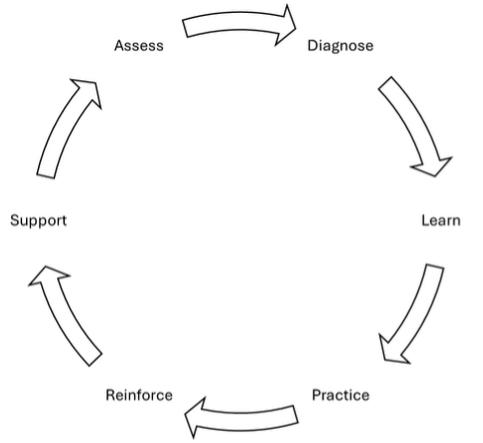The modern corporate learning department emerged in the mid-20th century as an efficient way to scale knowledge across an organization. In simple terms, knowledge was concentrated in the hands of a few, so those people were put in front of groups to share that knowledge. Technologies emerged to usher in even more efficiency, resulting in today’s mix of eLearning, virtual classroom and the occasional in-person experience. What all of these have in common is that they are content-centric.
Don’t get me wrong. Content is important but look at the mission statement for any corporate learning department and the word “content” isn’t to be seen. What you will find is the word performance or the words performance improvement.
Performance improvement is about making individuals, teams, or organizations more effective and efficient, and improving their results. It involves finding the difference between current and desired performance and using strategies – learning and others - to close that gap. Performance improvement isn’t a one-off event; it’s a process.
The performance improvement process
Performance improvement aims for measurable results like increased productivity, quality, efficiency, effectiveness, or satisfaction. While there are many performance improvement frameworks, most include some version of the following:
 |
|
|---|
Here are some examples of methods for each stage: |
|||||
|---|---|---|---|---|---|
Diagnose |
Learn |
Practice |
Reinforce |
Support |
Assess |
|
|
|
|
|
|
The (historical) barriers to performance improvement
It’s not because corporate learning departments don’t want to improve performance. Rather, there are very real barriers stopping them from doing so. The most common include:
Cultural barriers: organizations are accustomed to traditional learning models (content-heavy courses), and shifting to a performance-based approach requires a cultural shift.
Technology limitations: Many corporate learning platforms are built for content hosting rather than workflow-based support and real-world practice.
Resource limitations: Many learning departments struggle to gain access to internal experts and high performers to gain a deep understanding of what best practices look like in action, so the default is to abstract principles and frameworks.
Time constraints: Designing, developing and deploying robust performance solutions takes time and cross-department collaboration. The demand for solutions is often rushed and against tight deadlines.
Budget restrictions: Robust solutions that go beyond a content dump require greater investment and budgets are often limited.
The good news is that the world has changed. With the rise of technology generally and AI specifically, we now have the tools to do what corporate learning has always aspired to but never quite achieved. No more one-and-done training sessions. No more tick-box learning. Now, organizations can embrace the full performance cycle, drive measurable results, improve employee capabilities, and—dare we say—deliver results the organization desires.
Learning design example: first-rime manager training
Here's an example of a learning design for first-time managers, applying the performance improvement principles:
Diagnose:
A survey assesses new managers' current skills and identifies key challenges.
Interviews with experienced managers reveal critical success factors and common pitfalls.
Uses a simulation or AI-powered roleplay to evaluate starting knowledge and skill level.
Learn:
eLearning modules introduce fundamental management concepts (e.g., delegation, feedback, performance management).
Virtual workshops provide interactive sessions on communication skills and conflict resolution.
Practice:
AI-powered role-plays simulate common managerial scenarios (e.g., conducting performance reviews, addressing team conflict).
Participants develop action plans to address specific challenges in their own work.
Reinforce:
Microlearning modules offer ongoing tips and reminders.
Provide managers with tips and guidance to provide coach and support performance.
Support:
A digital resource library provides templates, checklists, and guides.
An AI-powered coach answers on-demand questions.
Assess:
360-degree feedback measures changes in management skills.
Performance data (e.g., team productivity, employee satisfaction) tracks the program's impact.
Conclusion
The focus of corporate learning is shifting from content delivery to performance improvement. By using a systematic approach that includes diagnosis, learning, practice, reinforcement, support, and assessment, organizations can overcome traditional barriers and achieve significant and measurable improvements in individual and organizational performance. New technologies provide powerful tools to facilitate this shift, enabling learning to drive real business results.